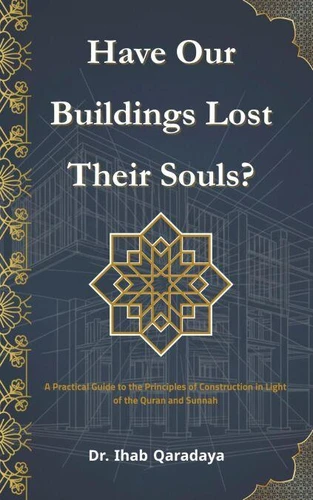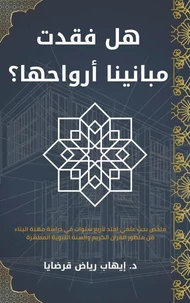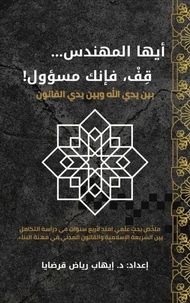Nouveauté
Have Our Buildings Lost Their Souls?: A Practical Guide to the Principles of Construction in Light of the Qur'an and Sunnah
Par :Formats :
Disponible dans votre compte client Decitre ou Furet du Nord dès validation de votre commande. Le format ePub est :
- Compatible avec une lecture sur My Vivlio (smartphone, tablette, ordinateur)
- Compatible avec une lecture sur liseuses Vivlio
- Pour les liseuses autres que Vivlio, vous devez utiliser le logiciel Adobe Digital Edition. Non compatible avec la lecture sur les liseuses Kindle, Remarkable et Sony
 , qui est-ce ?
, qui est-ce ?Notre partenaire de plateforme de lecture numérique où vous retrouverez l'ensemble de vos ebooks gratuitement
Pour en savoir plus sur nos ebooks, consultez notre aide en ligne ici
- FormatePub
- ISBN8232048914
- EAN9798232048914
- Date de parution08/11/2025
- Protection num.pas de protection
- Infos supplémentairesepub
- ÉditeurHamza elmir
Résumé
After more than thirty years in construction, Dr. Ihab Qaradaya noticed a disturbing gap: We build with engineering skill, but we often import "building cultures" that do not suit our communities. But where is the reference that combines the precision of engineering with the principles of the Qur'an and Sunnah?This book is the answer. As a summary of a 4-year PhD thesis, this is not just theory-it is a "practical guide" to fill this gap in both Islamic and engineering libraries.
This guide walks you step-by-step through the actual construction process:Chapter 1 (The "Why"): Understand the core concepts that must govern our work, from the true meaning of "building" in the Qur'an to the five ultimate goals of Islamic engineering and the ethical charter of the "Strong and Trustworthy" engineer. Chapter 2 (The ""How"-Design): Learn how to translate values like "Sakina" (tranquility), "Sitr" (privacy), and "No Harm" (the 1st law of engineering) into real blueprints, from the interior floor plan to the external facade.
Chapter 3 (The "Execution"): How to manage the construction site with integrity. This covers contracts (like FIDIC) in the light of Sharia, the ethics of selecting materials, and the critical importance of worker and public safety (HSE). Chapter 4 (The "Lifecycle"): Your responsibility doesn't end at handover. This chapter covers legal warranties (like the 10-year warranty), the owner's duty of maintenance, neighbor's rights, and the original "Islamic Green Building" code based on sustainability, water conservation, and recycling.
This book is an essential guide for every engineer who wants to add "soul" to their designs, and every owner who wants to build a true "home, " not just a structure.
This guide walks you step-by-step through the actual construction process:Chapter 1 (The "Why"): Understand the core concepts that must govern our work, from the true meaning of "building" in the Qur'an to the five ultimate goals of Islamic engineering and the ethical charter of the "Strong and Trustworthy" engineer. Chapter 2 (The ""How"-Design): Learn how to translate values like "Sakina" (tranquility), "Sitr" (privacy), and "No Harm" (the 1st law of engineering) into real blueprints, from the interior floor plan to the external facade.
Chapter 3 (The "Execution"): How to manage the construction site with integrity. This covers contracts (like FIDIC) in the light of Sharia, the ethics of selecting materials, and the critical importance of worker and public safety (HSE). Chapter 4 (The "Lifecycle"): Your responsibility doesn't end at handover. This chapter covers legal warranties (like the 10-year warranty), the owner's duty of maintenance, neighbor's rights, and the original "Islamic Green Building" code based on sustainability, water conservation, and recycling.
This book is an essential guide for every engineer who wants to add "soul" to their designs, and every owner who wants to build a true "home, " not just a structure.
After more than thirty years in construction, Dr. Ihab Qaradaya noticed a disturbing gap: We build with engineering skill, but we often import "building cultures" that do not suit our communities. But where is the reference that combines the precision of engineering with the principles of the Qur'an and Sunnah?This book is the answer. As a summary of a 4-year PhD thesis, this is not just theory-it is a "practical guide" to fill this gap in both Islamic and engineering libraries.
This guide walks you step-by-step through the actual construction process:Chapter 1 (The "Why"): Understand the core concepts that must govern our work, from the true meaning of "building" in the Qur'an to the five ultimate goals of Islamic engineering and the ethical charter of the "Strong and Trustworthy" engineer. Chapter 2 (The ""How"-Design): Learn how to translate values like "Sakina" (tranquility), "Sitr" (privacy), and "No Harm" (the 1st law of engineering) into real blueprints, from the interior floor plan to the external facade.
Chapter 3 (The "Execution"): How to manage the construction site with integrity. This covers contracts (like FIDIC) in the light of Sharia, the ethics of selecting materials, and the critical importance of worker and public safety (HSE). Chapter 4 (The "Lifecycle"): Your responsibility doesn't end at handover. This chapter covers legal warranties (like the 10-year warranty), the owner's duty of maintenance, neighbor's rights, and the original "Islamic Green Building" code based on sustainability, water conservation, and recycling.
This book is an essential guide for every engineer who wants to add "soul" to their designs, and every owner who wants to build a true "home, " not just a structure.
This guide walks you step-by-step through the actual construction process:Chapter 1 (The "Why"): Understand the core concepts that must govern our work, from the true meaning of "building" in the Qur'an to the five ultimate goals of Islamic engineering and the ethical charter of the "Strong and Trustworthy" engineer. Chapter 2 (The ""How"-Design): Learn how to translate values like "Sakina" (tranquility), "Sitr" (privacy), and "No Harm" (the 1st law of engineering) into real blueprints, from the interior floor plan to the external facade.
Chapter 3 (The "Execution"): How to manage the construction site with integrity. This covers contracts (like FIDIC) in the light of Sharia, the ethics of selecting materials, and the critical importance of worker and public safety (HSE). Chapter 4 (The "Lifecycle"): Your responsibility doesn't end at handover. This chapter covers legal warranties (like the 10-year warranty), the owner's duty of maintenance, neighbor's rights, and the original "Islamic Green Building" code based on sustainability, water conservation, and recycling.
This book is an essential guide for every engineer who wants to add "soul" to their designs, and every owner who wants to build a true "home, " not just a structure.





